Impact of Solar Activity on Global Atmospheric Circulation Based on SD-WACCM-X Simulations from 2002 to 2019
Abstract
:1. Introduction
2. Model and Method
2.1. SD-WACCM-X
2.2. Method
3. Results
4. Discussion and Conclusions
Author Contributions
Funding
Institutional Review Board Statement
Informed Consent Statement
Data Availability Statement
Acknowledgments
Conflicts of Interest
References
- Pfeffer, R.L. The global atmospheric circulation. Trans. N. Y. Acad. Sci. 1964, 26, 984–997. [Google Scholar] [CrossRef]
- Lamb, H.H. Atmospheric Circulation, Climate and Climatic Variations. Geography 1961, 46, 208–222. [Google Scholar] [CrossRef]
- Egger, J.; Weickmann, K.; Hoinka, K.P. Angular momentum in the global atmospheric circulation. Rev. Geophys. 2007, 45. [Google Scholar] [CrossRef] [Green Version]
- Voigt, A.; Shaw, T.A. Circulation response to warming shaped by radiative changes of clouds and water vapour. Nat. Geosci. 2015, 8, 102–106. [Google Scholar] [CrossRef]
- Schneider, T.; Bordoni, S. Eddy-mediated regime transitions in the seasonal cycle of a Hadley circulation and implications for monsoon dynamics. J. Atmos. Sci. 2008, 65, 915–934. [Google Scholar] [CrossRef] [Green Version]
- Heikes, R.; Thompson, D.W.J.; Butler, A.H. The Steady-state atmospheric circulation response to climate change–like thermal forcings in a simple general circulation model. J. Clim. 2010, 23, 3474–3496. [Google Scholar] [CrossRef]
- Ceppi, P.; Shepherd, T.G. Contributions of climate feedbacks to changes in atmospheric circulation. J. Clim. 2017, 30, 9097–9118. [Google Scholar] [CrossRef]
- Thompson, D.W.J.; Li, Y.; Bony, S. The influence of atmospheric cloud radiative effects on the large-scale atmospheric circulation. J. Clim. 2015, 28, 7263–7278. [Google Scholar] [CrossRef]
- Butchart, N. The brewer-dobson circulation. Rev. Geophys. 2014, 52, 157–184. [Google Scholar] [CrossRef]
- Maher, P.; Gerber, E.P.; Medeiros, B.; Merlis, T.M.; Sherwood, S.; Sheshadri, A.; Sobel, A.H.; Vallis, G.K.; Voigt, A.; Zurita-Gotor, P. Model hierarchies for understanding atmospheric circulation. Rev. Geophys. 2019, 57, 250–280. [Google Scholar] [CrossRef] [Green Version]
- Huth, R.; Beck, C.; Philipp, A.; Demuzere, M.; Ustrnul, Z.; Cahynova, M.; Kysely, J.; Tveito, O.E. Classifications of atmospheric circulation patterns: Recent advances and applications. Ann. N. Y. Acad. Sci. 2008, 1146, 105–152. [Google Scholar] [CrossRef]
- Hardiman, S.C.; Butchart, N.; Calvo, N. The morphology of the Brewer-Dobson circulation and its response to climate change in CMIP5 simulations. Q. J. R. Meteorol. Soc. 2014, 140, 1958–1965. [Google Scholar] [CrossRef]
- Lupikasza, E.B.; Niedzwiedz, T. The influence of mesoscale atmospheric circulation on spitsbergen air temperature in periods of arctic warming and cooling. J. Geophys. Res.-Atmos. 2019, 124, 5233–5250. [Google Scholar] [CrossRef]
- Noguchi, S.; Kuroda, Y.; Kodera, K.; Watanabe, S. Robust enhancement of tropical convective activity by the 2019 antarctic sudden stratospheric warming. Geophys. Res. Lett. 2020, 47, e2020GL088743. [Google Scholar] [CrossRef]
- Ruzmaikin, A.; Feynman, J.; Jiang, X.; Yung, Y.L. Extratropical signature of the quasi-biennial oscillation. J. Geophys. Res.-Atmos. 2005, 110. [Google Scholar] [CrossRef] [Green Version]
- White, I.P.; Lu, H.; Mitchell, N.J.; Phillips, T. Dynamical response to the QBO in the northern winter stratosphere: Signatures in wave forcing and eddy fluxes of potential vorticity. J. Atmos. Sci. 2015, 72, 4487–4507. [Google Scholar] [CrossRef] [Green Version]
- Garfinkel, C.I.; Shaw, T.A.; Hartmann, D.L.; Waugh, D.W. Does the Holton–Tan mechanism explain how the quasi-biennial oscillation modulates the arctic polar vortex? J. Atmos. Sci. 2012, 69, 1713–1733. [Google Scholar] [CrossRef]
- Lu, H.; Bracegirdle, T.J.; Phillips, T.; Bushell, A.; Gray, L. Mechanisms for the Holton-Tan relationship and its decadal variation. J. Geophys. Res.-Atmos. 2014, 119, 2811–2830. [Google Scholar] [CrossRef] [Green Version]
- Abalos, M.; Legras, B.; Ploeger, F.; Randel, W.J. Evaluating the advective Brewer-Dobson circulation in three reanalyses for the period 1979–2012. J. Geophys. Res.-Atmos. 2015, 120, 7534–7554. [Google Scholar] [CrossRef]
- Horel, J.D.; Wallace, J.M. Planetary-Scale atmospheric phenomena associated with the southern oscillation. Mon. Weather Rev. 1981, 109, 813–829. [Google Scholar] [CrossRef]
- Calvo, N.; Garcia, R.R.; Randel, W.J.; Marsh, D.R. Dynamical mechanism for the increase in tropical upwelling in the lowermost tropical stratosphere during warm ENSO events. J. Atmos. Sci. 2010, 67, 2331–2340. [Google Scholar] [CrossRef] [Green Version]
- Simpson, I.R.; Shepherd, T.G.; Sigmond, M. Dynamics of the lower stratospheric circulation response to ENSO. J. Atmos. Sci. 2011, 68, 2537–2556. [Google Scholar] [CrossRef] [Green Version]
- Andrews, D.G.; Holton, J.R.; Leovy, C.B. Middle Atmosphere Dynamics; Academic Press: Orlando, FL, USA, 1987; 489p. [Google Scholar]
- Gu, S.; Hou, X.; Qi, J.; TengChen, K.; Dou, X. Reponses of middle atmospheric circulation to the 2009 major sudden stratospheric warming. Earth Planet. Phys. 2020, 4, 1–7. [Google Scholar] [CrossRef]
- Garcia, R.R.; Randel, W.J. Acceleration of the Brewer-Dobson circulation due to increases in greenhouse gases. J. Atmos. Sci. 2008, 65, 2731–2739. [Google Scholar] [CrossRef]
- Choi, J.; Son, S.W.; Park, R.J. Aerosol versus greenhouse gas impacts on Southern Hemisphere general circulation changes. Clim. Dynam. 2019, 52, 4127–4142. [Google Scholar] [CrossRef]
- Roscoe, H.K.; Fowler, C.L.; Shanklin, J.D.; Hill, J.G.T. Possible long-term changes in stratospheric circulation: Evidence from total ozone measurements at the edge of the Antarctic vortex in early winter. Q. J. R. Meteorol. Soc. 2004, 130, 1123–1135. [Google Scholar] [CrossRef] [Green Version]
- Brandefelt, J. Atmospheric modes of variability in a changing climate. J. Clim. 2006, 19, 5934–5943. [Google Scholar] [CrossRef]
- Tandberg-Hanssen, E. Solar activity. Rev. Geophys. 1973, 11, 469–504. [Google Scholar] [CrossRef]
- Liu, L.B.; Wan, W.X.; Ning, B.Q.; Pirog, O.M.; Kurkin, V.I. Solar activity variations of the ionospheric peak electron density. J. Geophys. Res.-Space Phys. 2006, 111. [Google Scholar] [CrossRef]
- Fontanari, J.; Alcayde, D.; Bauer, P. Seasonal-changes in thermospheric molecular-oxygen—A Solar-Activity Control. Geophys. Res. Lett. 1982, 9, 551–554. [Google Scholar] [CrossRef]
- Kuroda, Y.; Deushi, M.; Shibata, K. Role of solar activity in the troposphere-stratosphere coupling in the Southern Hemisphere winter. Geophys. Res. Lett. 2007, 34. [Google Scholar] [CrossRef] [Green Version]
- Martinez-Asensio, A.; Tsimplis, M.N.; Calafat, F.M. Decadal variability of European sea level extremes in relation to the solar activity. Geophys. Res. Lett. 2016, 43, 11744–11750. [Google Scholar] [CrossRef] [Green Version]
- Warren, H.P.; Emmert, J.T.; Crump, N.A. Linear forecasting of the F10.7 proxy for solar activity. Space Weather 2017, 15, 1039–1051. [Google Scholar] [CrossRef]
- Lean, J.L.; Picone, J.M.; Emmert, J.T. Quantitative forecasting of near-term solar activity and upper atmospheric density. J. Geophys. Res.-Space Phys. 2009, 114. [Google Scholar] [CrossRef] [Green Version]
- Kutiev, I.; Tsagouri, I.; Perrone, L.; Pancheva, D.; Mukhtarov, P.; Mikhailov, A.; Lastovicka, J.; Jakowski, N.; Buresova, D.; Blanch, E.; et al. Solar activity impact on the Earth’s upper atmosphere. J. Space Weather Space Clim. 2013, 3, A06. [Google Scholar] [CrossRef] [Green Version]
- Schmidt, H.; Brasseur, G.P.; Giorgetta, M.A. Solar cycle signal in a general circulation and chemistry model with internally generated quasi-biennial oscillation. J. Geophys. Res.-Atmos. 2010, 115. [Google Scholar] [CrossRef] [Green Version]
- Bednarz, E.M.; Maycock, A.C.; Telford, P.J.; Braesicke, P.; Abraham, N.L.; Pyle, J.A. Simulating the atmospheric response to the 11-year solar cycle forcing with the UM-UKCA model: The role of detection method and natural variability. Atmos. Chem. Phys. 2019, 19, 5209–5233. [Google Scholar] [CrossRef] [Green Version]
- Wilcox, J.M. Solar-Activity and Changes in Atmospheric Circulation. J. Atmos. Terr. Phys. 1979, 41, 753. [Google Scholar] [CrossRef]
- Kodera, K.; Kuroda, Y. Dynamical response to the solar cycle. J. Geophys. Res.-Atmos. 2002, 107. [Google Scholar] [CrossRef] [Green Version]
- Koval, A.V.; Gavrilov, N.M.; Pogoreltsev, A.I.; Shevchuk, N.O. Reactions of the middle atmosphere circulation and stationary planetary waves on the solar activity effects in the thermosphere. J. Geophys. Res.-Space Phys. 2019, 124, 10645–10658. [Google Scholar] [CrossRef] [Green Version]
- Vasilyeva, L.A.; Zherebtsov, G.A.; Kovalenko, V.A.; Molodykh, S.I. Peculiarities of long-term variations in the temperature and heat content of the troposphere and their relation to solar activity. Geomagn. Aeron. 2009, 49, 1285–1287. [Google Scholar] [CrossRef]
- Sfica, L.; Voiculescu, M.; Huth, R. The influence of solar activity on action centres of atmospheric circulation in North Atlantic. Ann. Geophys. 2015, 33, 207–215. [Google Scholar] [CrossRef] [Green Version]
- Karlsson, B.; Kuilman, M. On how the middle atmospheric residual circulation responds to the solar cycle close to the solstices. J. Clim. 2018, 31, 401–421. [Google Scholar] [CrossRef]
- Salinas, C.C.J.H.; Chang, L.C.; Liang, M.C.; Qian, L.Y.; Yue, J.; Lee, J.N.; Russell, J.; Mlynczak, M.; Wu, D.L. Solar cycle response of CO2 over the austral winter mesosphere and lower thermosphere region. J. Geophys. Res.-Space Phys. 2018, 123, 7581–7597. [Google Scholar] [CrossRef]
- Rao, J.; Yu, Y.Y.; Guo, D.; Shi, C.H.; Chen, D.; Hu, D.Z. Evaluating the Brewer-Dobson circulation and its responses to ENSO, QBO, and the solar cycle in different reanalyses. Earth Planet. Phys. 2019, 3, 166–181. [Google Scholar] [CrossRef]
- Meehl, G.A.; Arblaster, J.M.; Matthes, K.; Sassi, F.; van Loon, H. Amplifying the pacific climate system response to a small 11-year solar cycle forcing. Science 2009, 325, 1114–1118. [Google Scholar] [CrossRef] [Green Version]
- Mills, M.J.; Schmidt, A.; Easter, R.; Solomon, S.; Kinnison, D.E.; Ghan, S.J.; Neely, R.R.; Marsh, D.R.; Conley, A.; Bardeen, C.G.; et al. Global volcanic aerosol properties derived from emissions, 1990–2014, using CESM1(WACCM). J. Geophys. Res.-Atmos. 2016, 121, 2332–2348. [Google Scholar] [CrossRef] [Green Version]
- Ramesh, K.; Smith, A.K. Long-Term variability and tendencies in non-migrating diurnal tide from WACCM6 simulations during 1850–2014. J. Geophys. Res. Space Phys. 2021, 126, e2020JA028904. [Google Scholar] [CrossRef]
- Marsh, D.R.; Mills, M.J.; Kinnison, D.E.; Lamarque, J.-F.; Calvo, N.; Polvani, L.M. Climate change from 1850 to 2005 simulated in CESM1(WACCM). J. Clim. 2013, 26, 7372–7391. [Google Scholar] [CrossRef] [Green Version]
- Chandran, A.; Collins, R.L. Stratospheric sudden warming effects on winds and temperature in the middle atmosphere at middle and low latitudes: A study using WACCM. Ann. Geophys. 2014, 32, 859–874. [Google Scholar] [CrossRef] [Green Version]
- Lean, J.; Rottman, G.; Harder, J.; Kopp, G. SORCE contributions to new understanding of global change and solar variability. Sol. Phys. 2005, 230, 27–53. [Google Scholar] [CrossRef]
- Kopp, G.; Lean, J.L. A new, lower value of total solar irradiance: Evidence and climate significance. Geophys. Res. Lett. 2011, 38. [Google Scholar] [CrossRef] [Green Version]
- Teng, C.K.M.; Gu, S.Y.; Qin, Y.; Dou, X.; Li, N.; Tang, L. Unexpected decrease in TW3 amplitude during antarctic sudden stratospheric warming events as revealed by SD-WACCM-X. J. Geophys. Res.-Space Phys. 2021, 126. [Google Scholar] [CrossRef]
- Qin, Y.; Gu, S.Y.; Teng, C.K.M.; Dou, X.K.; Yu, Y.; Li, N. Comprehensive study of the climatology of the quasi-6-day wave in the MLT region based on Aura/MLS observations and SD-WACCM-X simulations. J. Geophys. Res.-Space Phys. 2020, 126. [Google Scholar] [CrossRef]
- Liu, H.L.; Bardeen, C.G.; Foster, B.T.; Lauritzen, P.H.; Liu, J.; Lu, G.; Marsh, D.R.; Maute, A.; McInerney, J.M.; Pedatella, N.M.; et al. Development and validation of the whole atmosphere community climate model with thermosphere and ionosphere extension (WACCM-X 2.0). J. Adv. Model. Earth Syst. 2018, 10, 381–402. [Google Scholar] [CrossRef]
- Liu, H.L.; Foster, B.T.; Hagan, M.E.; McInerney, J.M.; Maute, A.; Qian, L.; Richmond, A.D.; Roble, R.G.; Solomon, S.C.; Garcia, R.R.; et al. Thermosphere extension of the whole atmosphere community climate model. J. Geophys. Res.-Space Phys. 2010, 115. [Google Scholar] [CrossRef] [Green Version]
- Marsh, D.R. Chemical–Dynamical coupling in the mesosphere and lower thermosphere. In Aeronomy of the Earth’s Atmosphere and Ionosphere; Abdu, M.A., Pancheva, D., Eds.; Springer: Dordrecht, The Netherlands, 2011; pp. 3–17. [Google Scholar]
- Gelaro, R.; McCarty, W.; Suarez, M.J.; Todling, R.; Molod, A.; Takacs, L.; Randles, C.; Darmenov, A.; Bosilovich, M.G.; Reichle, R.; et al. The Modern-Era retrospective analysis for research and applications, version 2 (MERRA-2). J. Clim. 2017, 30, 5419–5454. [Google Scholar] [CrossRef]
- Djurovic, D.; Paquet, P. The frequency composition of the madden-julian oscillation—An indication of the solar-activity contribution to the global atmospheric circulation and the earth’s rotation. Sol. Phys. 1994, 152, 497–504. [Google Scholar] [CrossRef]
- Liu, H.L.; Marsh, D.R.; She, C.Y.; Wu, Q.; Xu, J. Momentum balance and gravity wave forcing in the mesosphere and lower thermosphere. Geophys. Res. Lett. 2009, 36. [Google Scholar] [CrossRef] [Green Version]
- Bazilevskaya, G.; Broomhall, A.M.; Elsworth, Y.; Nakariakov, V.M. A combined analysis of the observational aspects of the quasi-biennial oscillation in solar magnetic activity. Space Sci. Rev. 2014, 186, 359–386. [Google Scholar] [CrossRef]
- Kane, R.P. Differences in the quasi-biennial oscillation and quasi-triennial oscillation characteristics of the solar, interplanetary, and terrestrial parameters. J. Geophys. Res.-Space Phys. 2005, 110. [Google Scholar] [CrossRef] [Green Version]
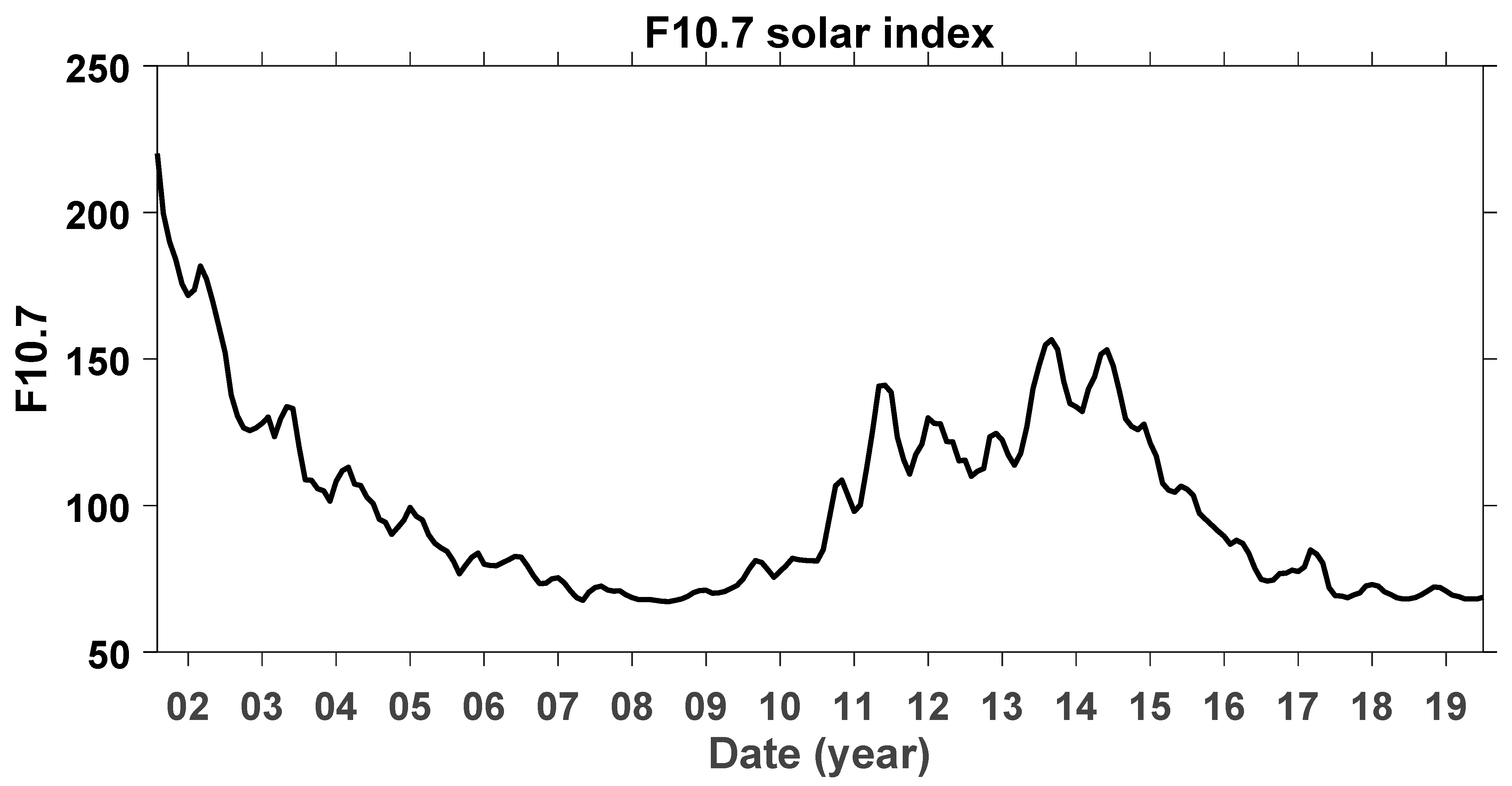
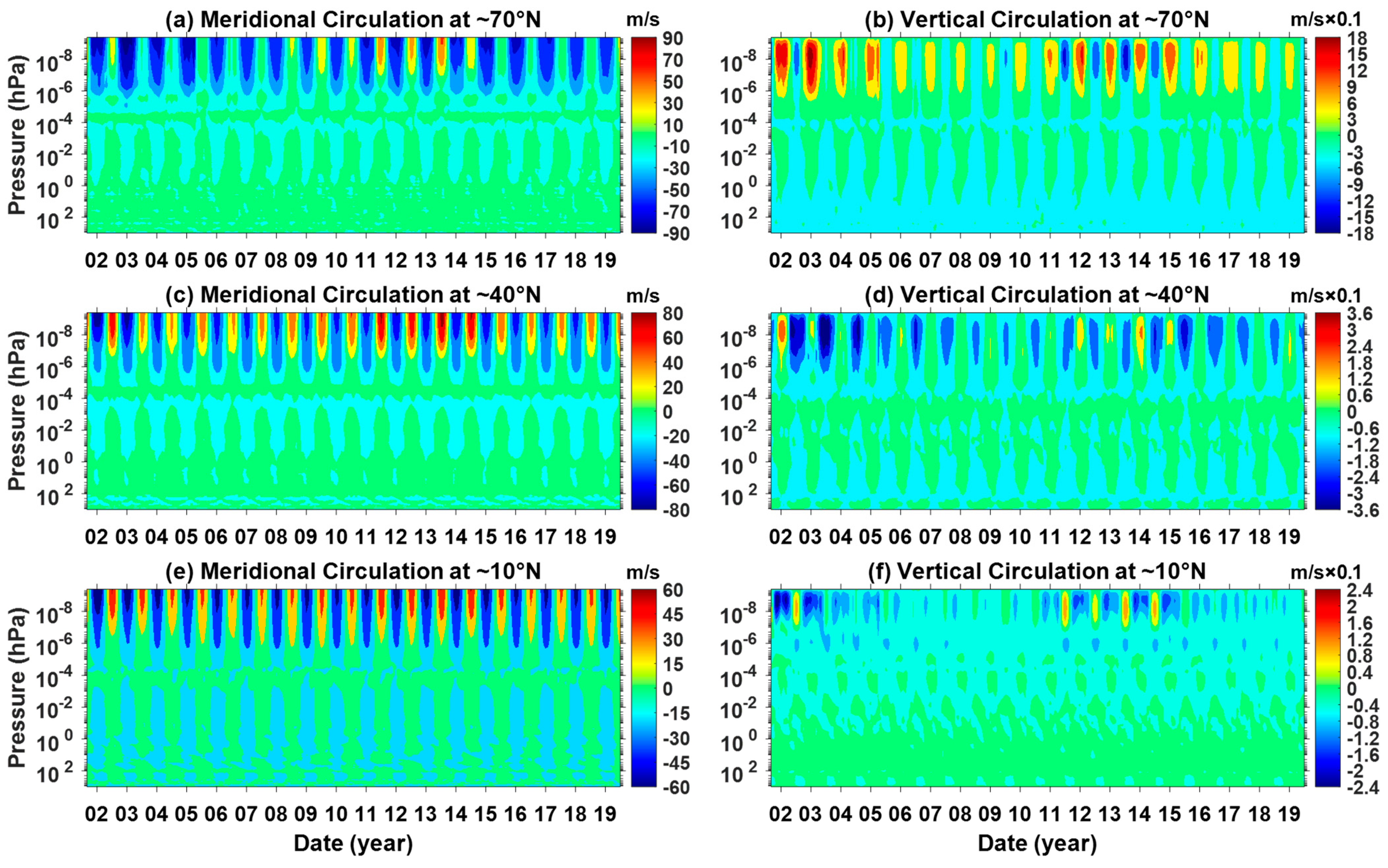
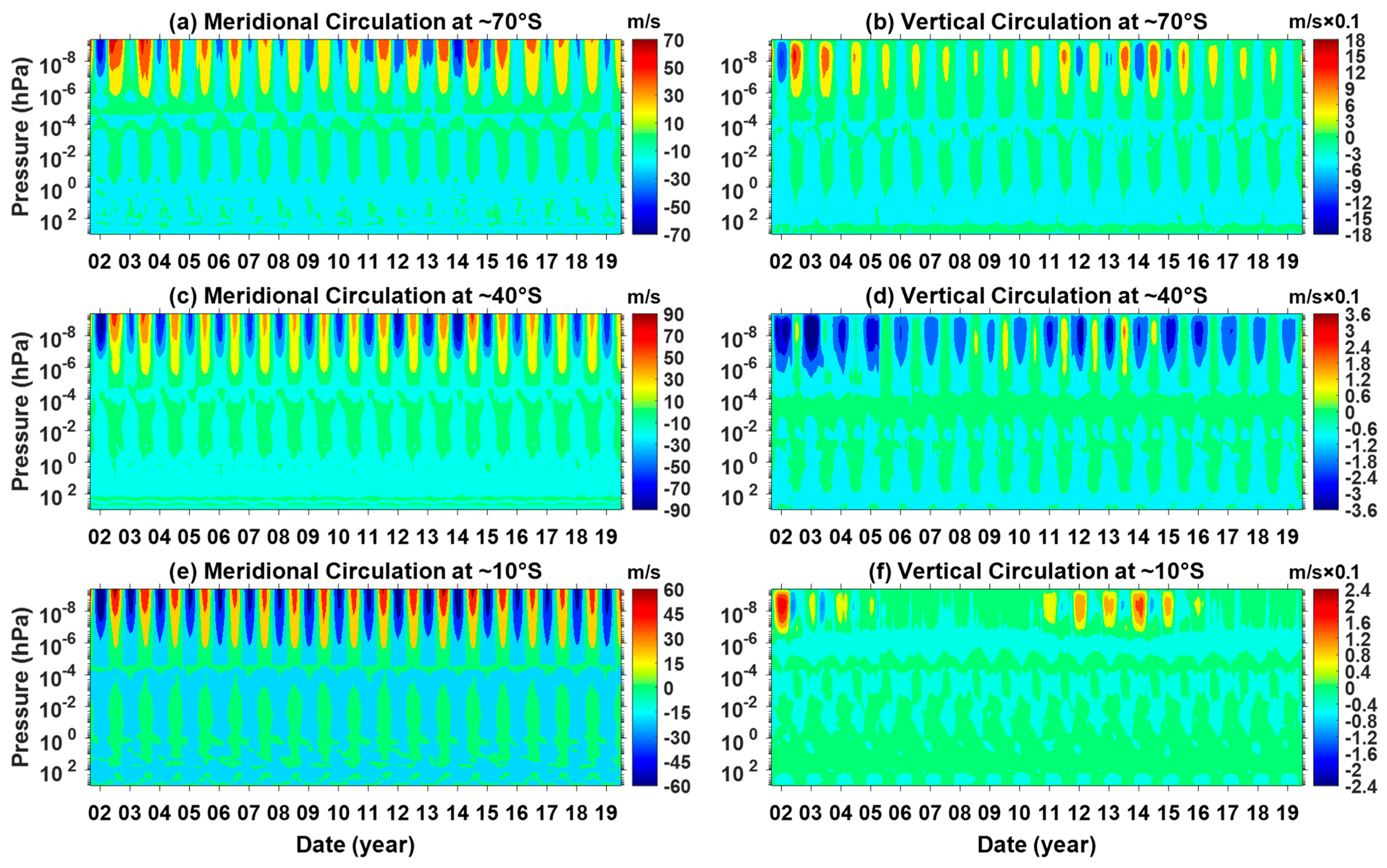

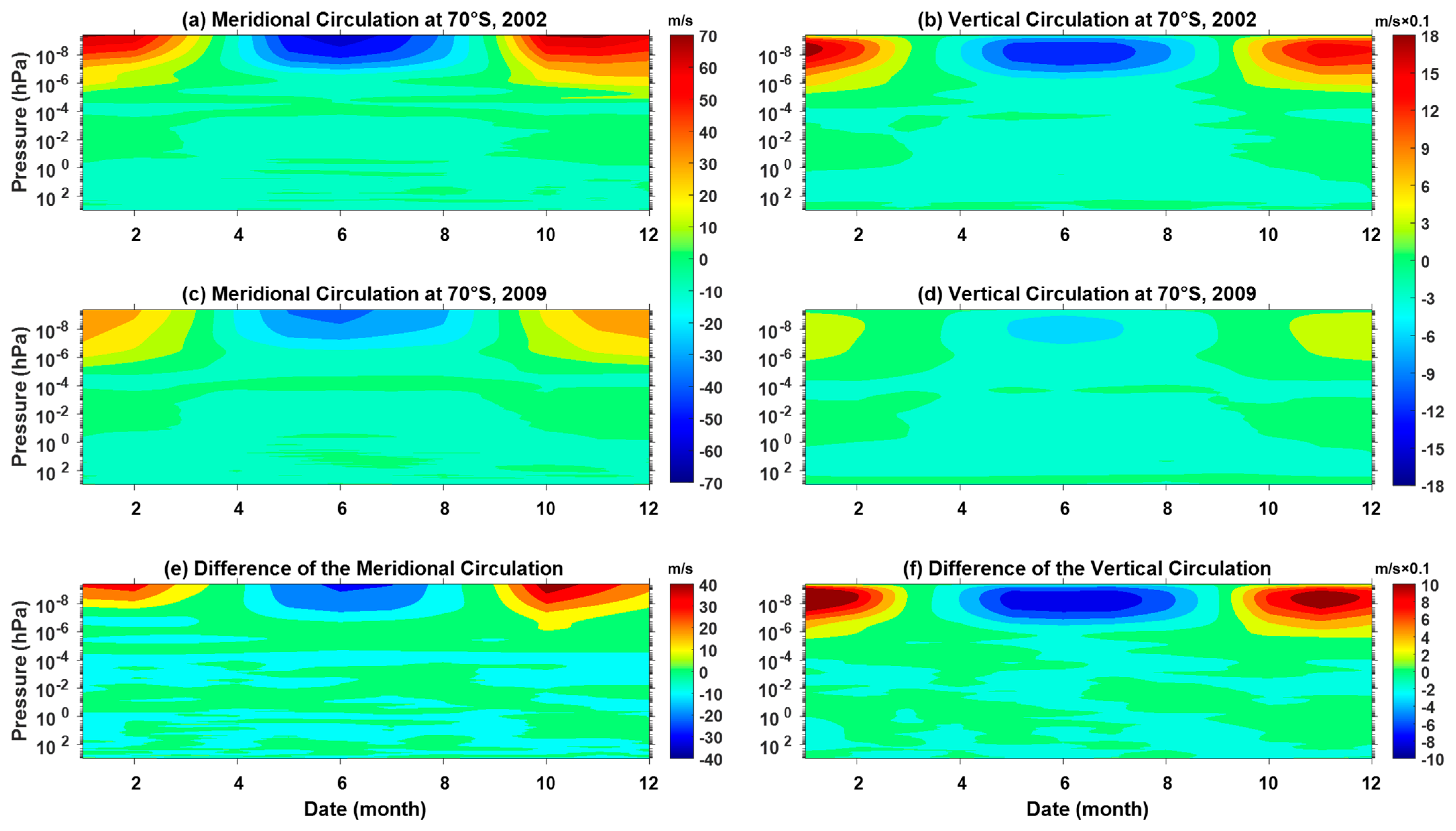
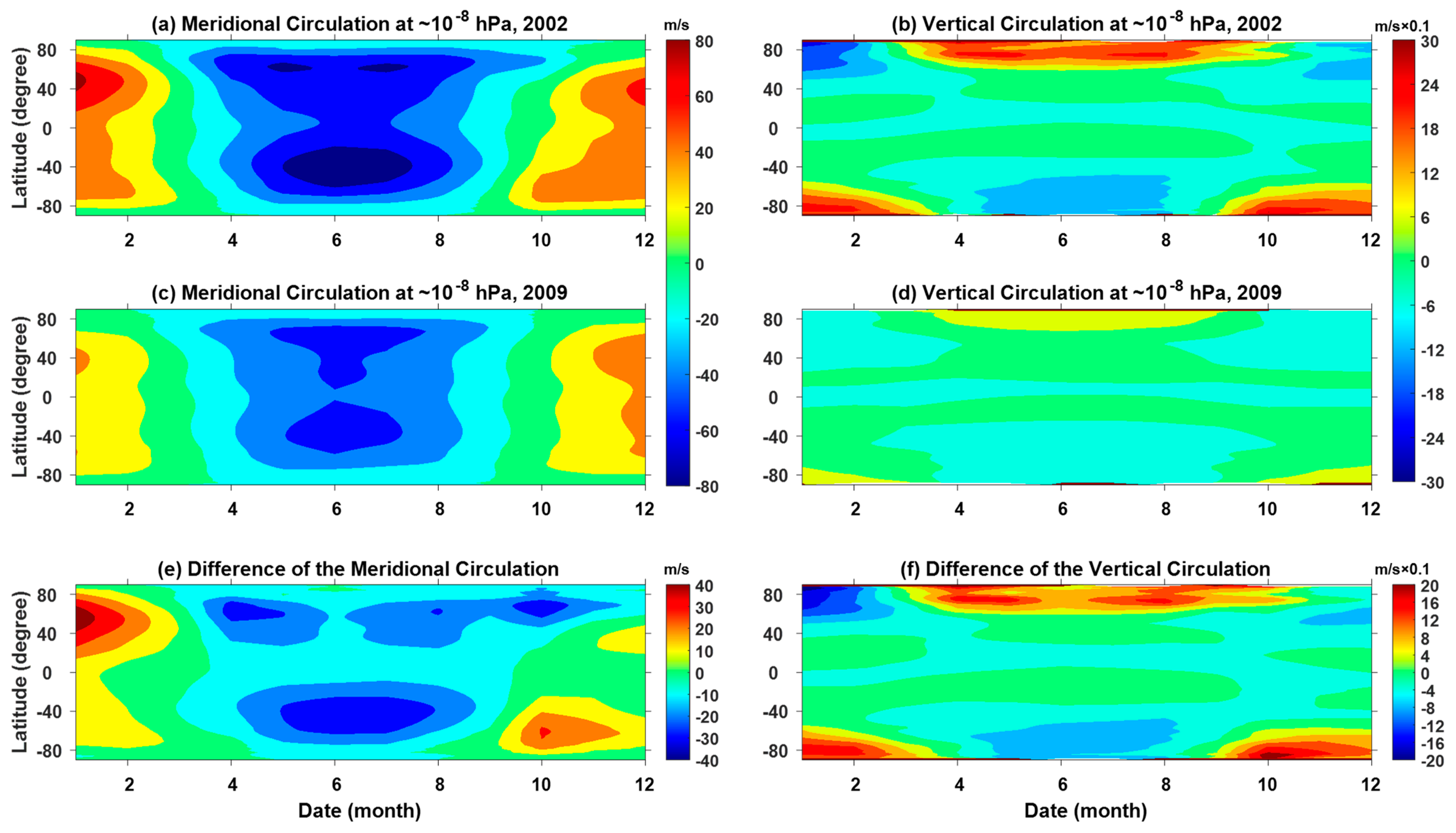
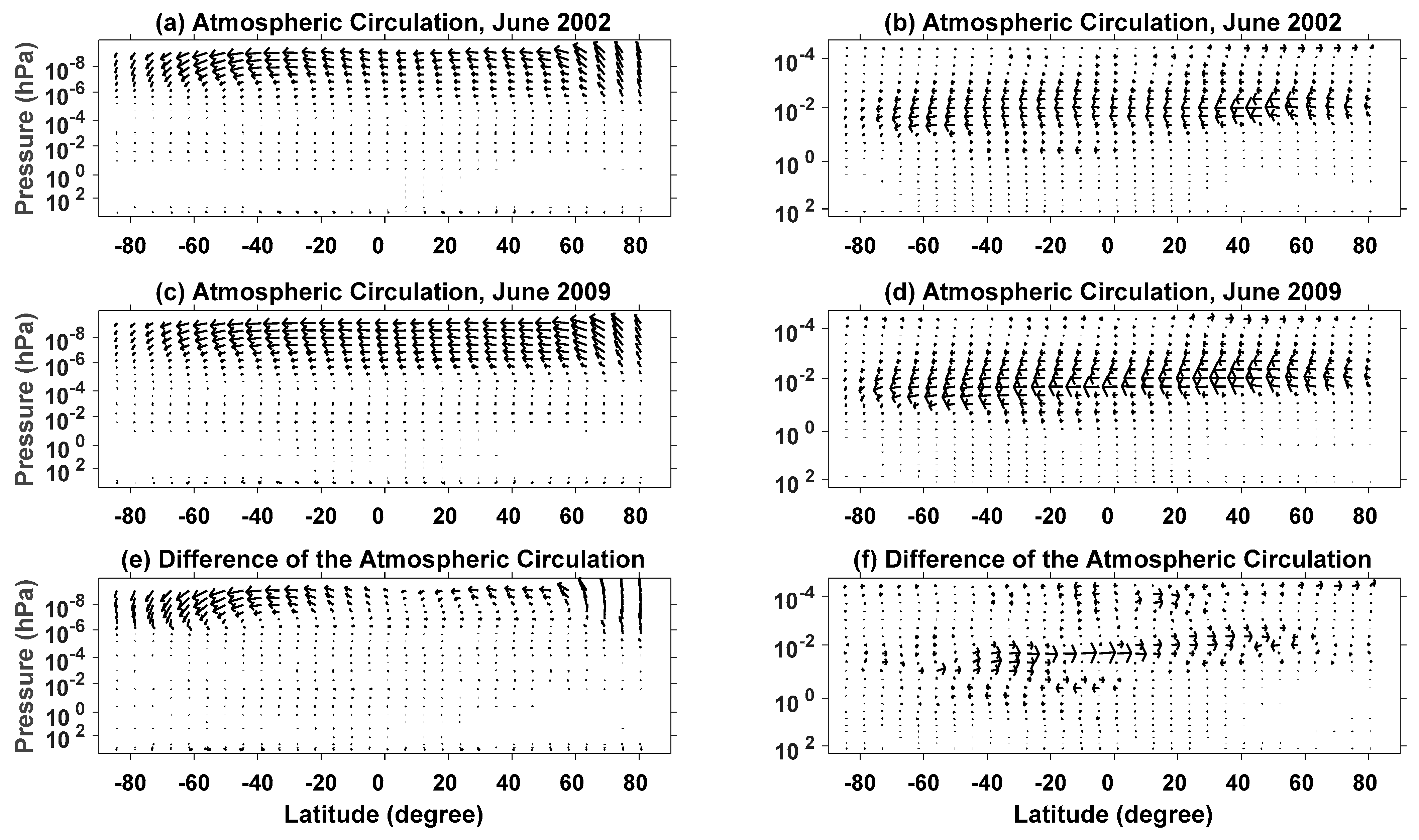
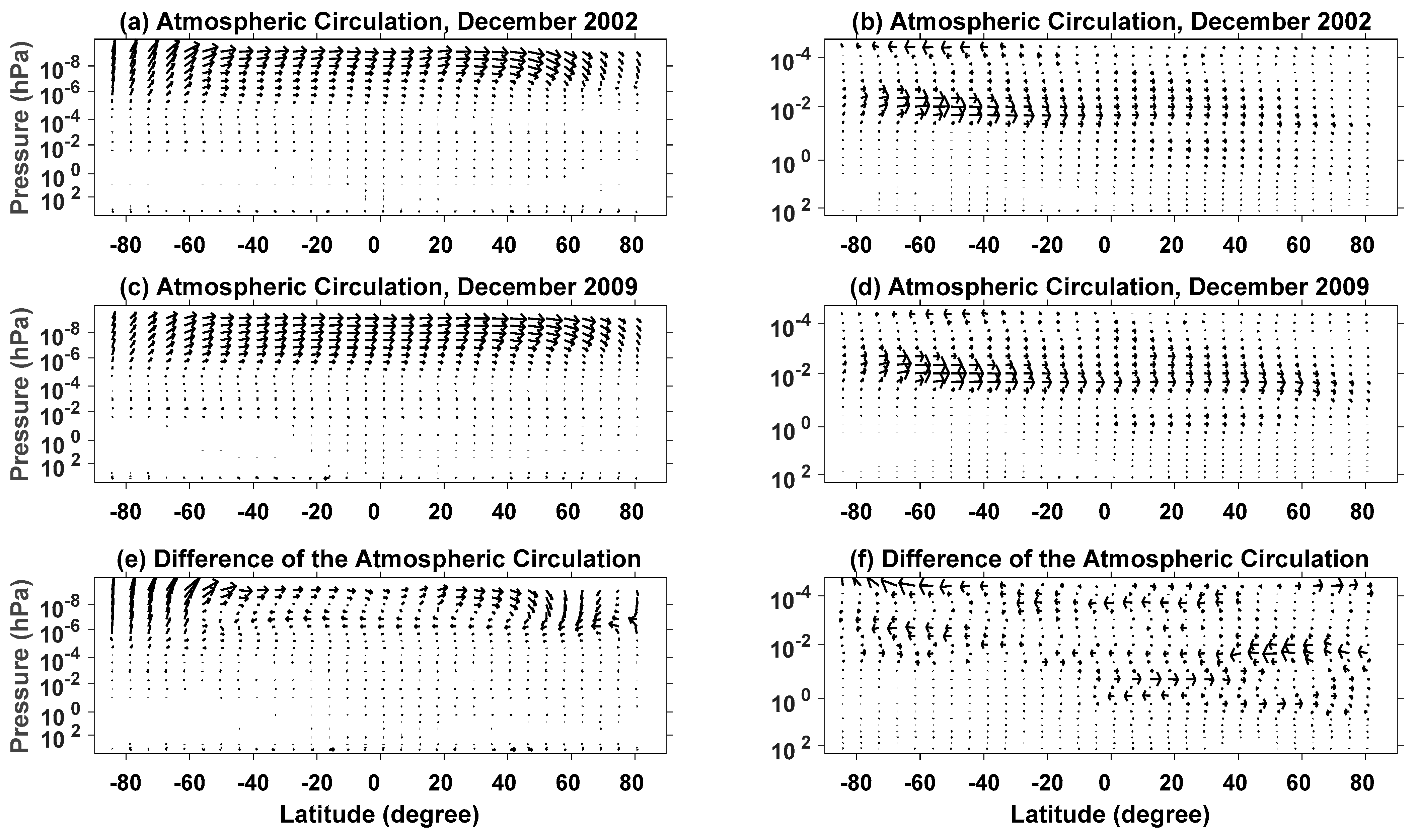




| V* | W* | |||||||||||
|---|---|---|---|---|---|---|---|---|---|---|---|---|
| June | ||||||||||||
| 70° S | 40° S | 10° S | 10° N | 40° N | 70° N | 70° S | 40° S | 10° S | 10° N | 40° N | 70° N | |
| ~10−8 hPa | 0.3789 | 0.7381 | 0.7768 | 0.6250 | 0.8452 | 0.5510 | 0.7891 | 0.5166 | 0.8430 | 0.1907 | 0.8150 | 0.9216 |
| ~10−4 hPa | −0.4288 | 0.0846 | 0.0273 | −0.2319 | 0.2645 | 0.4743 | 0.3122 | −0.0606 | −0.4161 | 0.1208 | 0.1968 | 0.1728 |
| ~10−2 hPa | 0.2753 | −0.2564 | 0.1160 | −0.1381 | −0.3202 | −0.2613 | 0.4057 | −0.1733 | 0.1088 | −0.4923 | −0.3533 | 0.1618 |
| December | ||||||||||||
| ~10−8 hPa | 0.7225 | 0.8894 | 0.8035 | 0.8540 | 0.8432 | 0.5247 | 0.9135 | 0.6060 | 0.9459 | 0.5196 | 0.1578 | 0.8183 |
| ~10−4 hPa | 0.3767 | 0.4411 | 0.1318 | −0.1752 | 0.0882 | −0.0155 | 0.0001 | −0.2074 | −0.0946 | −0.1109 | −0.3091 | 0.0348 |
| ~10−2 hPa | 0.5081 | −0.0304 | 0.0961 | −0.0202 | −0.0502 | −0.2743 | 0.1901 | −0.1972 | 0.2990 | −0.1924 | 0.2564 | −0.5831 |
Publisher’s Note: MDPI stays neutral with regard to jurisdictional claims in published maps and institutional affiliations. |
© 2021 by the authors. Licensee MDPI, Basel, Switzerland. This article is an open access article distributed under the terms and conditions of the Creative Commons Attribution (CC BY) license (https://creativecommons.org/licenses/by/4.0/).
Share and Cite
Teng, C.-K.-M.; Gu, S.-Y.; Qin, Y.; Dou, X. Impact of Solar Activity on Global Atmospheric Circulation Based on SD-WACCM-X Simulations from 2002 to 2019. Atmosphere 2021, 12, 1526. https://doi.org/10.3390/atmos12111526
Teng C-K-M, Gu S-Y, Qin Y, Dou X. Impact of Solar Activity on Global Atmospheric Circulation Based on SD-WACCM-X Simulations from 2002 to 2019. Atmosphere. 2021; 12(11):1526. https://doi.org/10.3390/atmos12111526
Chicago/Turabian StyleTeng, Chen-Ke-Min, Sheng-Yang Gu, Yusong Qin, and Xiankang Dou. 2021. "Impact of Solar Activity on Global Atmospheric Circulation Based on SD-WACCM-X Simulations from 2002 to 2019" Atmosphere 12, no. 11: 1526. https://doi.org/10.3390/atmos12111526
APA StyleTeng, C.-K.-M., Gu, S.-Y., Qin, Y., & Dou, X. (2021). Impact of Solar Activity on Global Atmospheric Circulation Based on SD-WACCM-X Simulations from 2002 to 2019. Atmosphere, 12(11), 1526. https://doi.org/10.3390/atmos12111526







